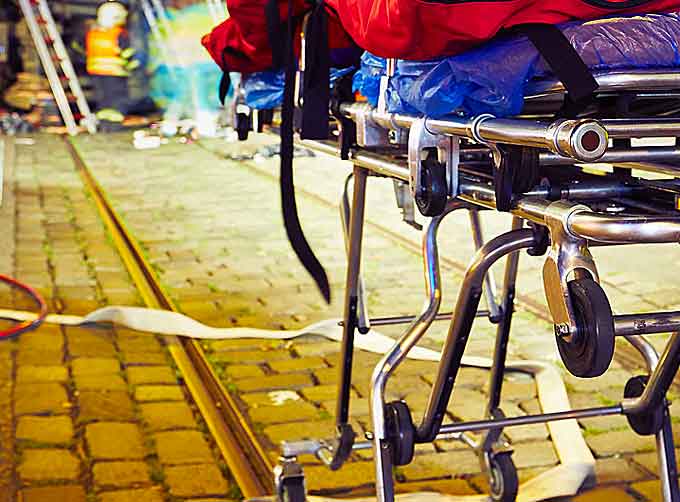
By Barry Bachenheimer, EdD, FF/EMT
“’Left of bang’ means before the bad stuff happens. That’s where you want to be—alert, ready, prepared to respond to protect yourself and your loved ones.”
―Patrick Van Horne, Left of Bang: How the Marine Corps’ Combat Hunter Program Can Save Your Life1
When it comes to emergency medical response to schools, EMS often responds in situations ex-Marine Patrick Van Horne calls “right of bang”: after something bad has happened.
It doesn’t have to be something tactical or horrific like an active shooter—anytime EMS responds following a 9-1-1 call, it is considered “right of bang.”
While most of the recent talk about school preparation involves law enforcement, there are many things local EMS can do to interface with the schools in its district to increase everyone’s collective readiness and stay “left of bang.”
(An explanation of the purpose and theme of the book Left of Bang, authored by Patrick Van Horne and Jason A. Riley. Left of Bang refers to the time before an event occurs, such as an attack. Being left of bang means taking the initiative to be aware, identify potential threatening people and situations, and then either avoiding them or deterring them. Courtesy of Jason Riley and YouTube. Posted on Sep 7, 2014.)
Physical Plant Assessment
Have your crews visited the schools in your response area? If not, this would be a good place to start.
Do it before there is an emergency.
Things to identify could include:
- Do you have maps of all the school buildings in your ambulances?
- Where are possible places to park ambulances?
- If law enforcement or fire units are blocking your normal points of access, are there alternative places to go?
- Where is the closest landing zone for aeromedical?
- Where would appropriate command and staging areas be?
- Are there multiple floors in the building? Where is the elevator?
- Does your stretcher fit in the elevator?
- How does your crew access elevator controls or an elevator key?
- Where is the school nurse’s office? Most medical and minor trauma calls will have your units responding there.
- Is it a secure building? If so, how will your crews access it?
- How about after-hours access if there is an evening activity or custodian injury?
- How do you access the fields?
- If there is an athletic injury, will the ambulance be able to get to the fields or gymnasium?
- Does the school have carts to facilitate patient movement if needed?
Communications
Communication both to and from the school, as well as inside it, is an area to think about.
- Do all classrooms have phones and the ability to dial 9-1-1?
- Will your radios work in all areas of the school, or are there dead zones?
- Will you be able to get a cell phone signal in all areas of the building?
- Does the school have walkie-talkies and its own channel?
- Can you communicate on that channel with your radio system?
- How does the school respond when there is a routine medical emergency?
- Do occupants shelter in place? Do they lock down?
- For both logistical and privacy purposes, it might be prudent to have students and staff out of the hallways when you transport a patient.
Equipment
Many schools have a nurse who is responsible for initial treatment of ill and injured students and staff. This is a good person to start with.
Find out his/her level of experience and understanding of the local EMS system and its capabilities.
Are you BLS (Basic life Support)-only or an ALS (Advance Life Support) service ? Does the nurse understand the difference?
Understanding what equipment and medications the school nurse has helps with your preparedness.
Does she have a jump bag? Consider recommending some supplies she could keep handy.
Often school nurses can administer certain medications prior to EMS arrival, including EpiPens, glucagon, Benadryl, inhalers, and Narcan.
Do your protocols line up with the school’s? It is a good discussion to have prior to an issue.
Most schools are required to have at least a few CPR-certified staff members, and nearly all have AEDs (automated external defibrillators) on site.
Local EMS can help inspect and maintain the AEDs.
Training
Beyond CPR, many school staff do not have first aid or other training.
Recent research has shown that active-shooter incidents don’t last long.
According to a 2013 FBI study, “In 64 incidents where the duration of the incident could be ascertained, 44 (69.0%)…ended in 5 minutes or less, with 23 ending in 2 minutes or less.”2
A person is shot every few seconds in these incidents, and it takes time for EMS to arrive and access the scene.
Bystander training in bleeding control would help save lives in these situations.
Offer to train teachers and staff members in bleeding-control strategies, including the use of tourniquets and hemostatic gauze.
(Learn how and when to use a tourniquet so that you can save a life. Courtesy of The National Center for Disaster Medicine and Public Health and YouTube. Posted on Sep 5, 2017.)
Recommend schools purchase individual bleeding-control kits or wall-mounted kits to place near the AEDs.
Additional training could include basic first aid or CPR certification for school staff.
The key with all of this is getting staff to be able to function in a high-stress environment. EMS is used to this, but school staff aren’t.
For people to act in a high-stress situation, they need to be able to say:
- “I know what to do,”
- “My participation makes a difference,”
- “I feel supported if I take action.”
Working with school staff to provide detailed training can empower them to act prior to EMS arrival.
We never want our school staff to say, “I didn’t know what to do.”
(S.T.A.T. Tourniquet’s intuitive design, allows civilians to use it without prior bleed control training in the event of an emergency. See in Action! Courtesy of S.T.A.T. Tourniquet and YouTube. Posted on Apr 11, 2017.)
Practice
Many local law enforcement agencies drill frequently at schools, practicing their active-shooter response plans.
EMS should work with law enforcement to conduct rescue task force training for warm-zone operations—this enables EMS to learn the layout of the school.
Additionally, have school administrators run tabletop drills that include law enforcement, EMS, the fire department, emergency management, and local government to review responsibilities, evacuation locations, reunification locations, communication protocols for parents and the community, and mutual aid agreements.
EMS will play an important role in these areas and will often be on scene for parents and other possible patients long after the incident has ended.
Final Thoughts
For any event that happens in a school, EMS will respond.
With some planning and practice, response to schools can be a more efficient and coordinated effort.
References
1. Van Horne P, Riley J. Left of Bang: How the Marine Corps’ Combat Hunter Program Can Save Your Life. Black Irish Entertainment, 2014.
2. U.S. Department of Justice, Federal Bureau of Investigations. A Study of Active Shooter Incidents in the United States Between 2000 and 2013, www.fbi.gov/file-repository/active-shooter-study-2000-2013-1.pdf.
About the Author:

















